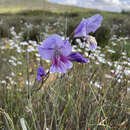Biology
(
Inglês
)
fornecido por Arkive
The blue Afrikaner flowers between the months of August and September (2), when the strong scent of the blooms attract bees, which carry out pollination. The shape of the flower readily accommodates the head and thorax of the bee, and as it climbs into the flower in search of a sip of nectar, it receives a dusting of pollen (6). The blue Afrikaner is primarily pollinated by Anthophora bee species (A. diversipes, A. krugeri, and A. schulzei) and the European honey bee Apis mellifera (7).
Conservation
(
Inglês
)
fornecido por Arkive
Within the Cape Floristic Region there are a number of protected areas (10), and a number of conservation organisations are working to conserve this botanically rich habitat. Conservation actions include purchasing land to protect it from the threats of encroaching agriculture and urban development (11), the removal of alien plants, and the establishment of new protected areas (8), measures which should hopefully protect the rare subspecies of the blue Afrikaner from becoming seriously threatened.
Description
(
Inglês
)
fornecido por Arkive
The blue Afrikaner, a member of the iris family, has an unusual purple stem, mottled with white. The strongly scented flowers may be shades of blue, violet or yellow, and occasionally pink, and measure up to 30 millimetres wide (2) (4). The narrow, grass-like leaves of the blue Afrikaner have a prominent midrib, and underground, food for the plant is stored in a swollen stem base (2) (5).
Habitat
(
Inglês
)
fornecido por Arkive
Inhabits sandstone slopes or deep coastal sands (2).
Range
(
Inglês
)
fornecido por Arkive
The blue Afrikaner occurs in South Africa, where it is distributed from Namaqualand, south and east to Knysna (2).
Status
(
Inglês
)
fornecido por Arkive
Subspecies Gladiolus carinatus parviflorus is classified as Rare on the Red Data List of Southern African Plants (3).
Threats
(
Inglês
)
fornecido por Arkive
Although the blue Afrikaner species is not currently considered threatened, the subspecies G. c. parviflorus has been classified as Rare, meaning that the population is so small, an unexpected threat could cause a critical decline (3). The blue Afrikaner occurs in the Cape Floristic Region, an area of incredibly high plant diversity, which is known to be threatened by urban expansion, the encroachment of agriculture, and the invasion of alien plant species (8) (9).
Gladiolus carinatus
(
Inglês
)
fornecido por wikipedia EN
Gladiolus carinatus, commonly as the blue Afrikaner, is a perennial plant belonging to the genus Gladiolus and is part of the fynbos. The plant is native to the Western Cape.[2]
Gallery
References

- licença
- cc-by-sa-3.0
- direitos autorais
- Wikipedia authors and editors
Gladiolus carinatus: Brief Summary
(
Inglês
)
fornecido por wikipedia EN
Gladiolus carinatus, commonly as the blue Afrikaner, is a perennial plant belonging to the genus Gladiolus and is part of the fynbos. The plant is native to the Western Cape.
- licença
- cc-by-sa-3.0
- direitos autorais
- Wikipedia authors and editors
Gladiolus carinatus
(
Vietnamita
)
fornecido por wikipedia VI
Gladiolus carinatus là một loài thực vật có hoa trong họ Diên vĩ. Loài này được Aiton miêu tả khoa học đầu tiên năm 1789.[1]
Chú thích
Liên kết ngoài
- licença
- cc-by-sa-3.0
- direitos autorais
- Wikipedia tác giả và biên tập viên
Gladiolus carinatus: Brief Summary
(
Vietnamita
)
fornecido por wikipedia VI
Gladiolus carinatus là một loài thực vật có hoa trong họ Diên vĩ. Loài này được Aiton miêu tả khoa học đầu tiên năm 1789.
- licença
- cc-by-sa-3.0
- direitos autorais
- Wikipedia tác giả và biên tập viên

